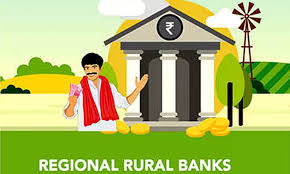The proposed merger reduces the number of RRBs from 43 to 28 to make them more efficient.
Consolidation is also derived from vision of One State-One RRB. Consolidation of RRBs
RRBs have been consolidated in a phased manner based on recommendations of Dr. Vyas Committee (2001).
Consolidation began in 2004-05 which resulted in reduction of such institutions from 196 to 43 till 2020-21 through 3
phases of amalgamation.
Significance of consolidation: Minimised overhead expenses, technology adoption, enhanced capital base and area of
operation, and increased exposure.

In a bid to achieve operational efficiency and cost rationalisation, the Finance Ministry has initiated the fourth round of consolidation for Regional Rural Banks (RRBs) and the number of such banks is likely to come down to 28 from 43 at present.
As per the roadmap prepared by the Finance Ministry, 15 RRBs operating in various states would be merged.
Among states that will see consolidation of RRBs include Andhra Pradesh, which has the maximum number of RRBs (4), Uttar Pradesh and West Bengal (3 each), and Bihar, Gujarat, Jammu & Kashmir, Karnataka, Madhya Pradesh, Maharashtra, Odisha and Rajasthan (2 each)
In the case of Telangana, the amalgamation of RRBs will be subject to bifurcation of assets and liabilities of Andhra Pradesh Grameena Vikas Bank (APGVB) between APGVB and Telangana Grameena Bank.
“Given the rural expansion of RRBs and agro-climatic or geographical ethos and in order to retain the USP of RRBs viz the closeness to communities, it is the felt need to embark on further consolidation of RRBs towards the goal of ‘One State-One RRB’ so as to derive the benefit of scale efficiency and cost rationalisation,” Department of Financial Services said in a communication to head of state-owned banks.
Consolidation of RRBs started in 2004-05 and after three phases of amalgamation, the number has come down to 43 from 196. This has helped RRBs “minimise their overhead expenses, optimise the use of technology, enhance the capital base and area of operation, and increase their exposure”.
“Given the rural expansion of RRBs and agro-climatic/geographical ethos and in order to retain the USP of RRBs viz. closeness to communities, it is the felt need to embark on further consolidation of RRBs .
